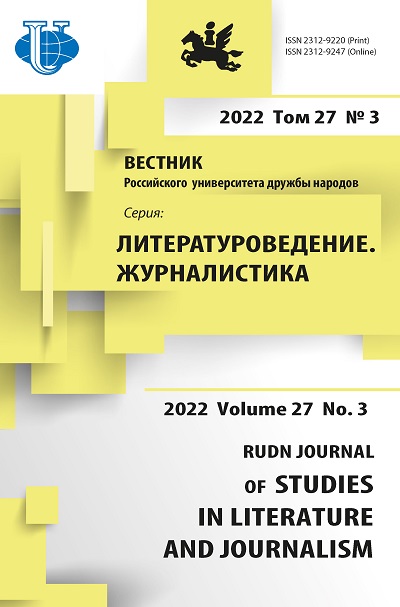Диаспорное сознание в современной индийской женской прозе на английском языке: краткий обзор
- Авторы: Кадам Д.М.1
-
Учреждения:
- Технологический институт Раджарамбапу
- Выпуск: Том 27, № 3 (2022)
- Страницы: 532-540
- Раздел: Литературоведение
- URL: https://journals.rudn.ru/literary-criticism/article/view/32306
- DOI: https://doi.org/10.22363/2312-9220-2022-27-3-532-540
- ID: 32306
Цитировать
Полный текст
Аннотация
Диаспорная литература - ключевой термин в литературе, включающий в себя литературные произведения авторов, которые являются аутсайдерами для своей родной страны, но их творчество глубоко укоренено на родине, отражая местную культуру, происхождение, перемещение и т. д. Литературное творчество индийских женщин находится в авангарде литературы диаспоры. Появление индийских писательниц на литературном горизонте является важным событием в индийско-английской литературе. Эти женщины-писатели также внесли вклад в другие жанры, такие как драма, поэзия и короткие рассказы, не только на английском, но и на региональных языках: хинди, маратхи, бенгальский, панджаби, тамильский, каннада и др. Некоторые современные женщины-писательницы процветают, впечатляющим образом используя в своем творчестве форму басен, чтобы сосредоточиться на конкретных темах. Последние два десятилетия характеризуются расцветом творчества индийских женщин, писавших на английском языке и публиковавшихся как в Индии, так и за рубежом. Настоящая работа представляет собой обзор диаспорного сознания в избранных произведениях современных индийских писательниц. Предпринимается попытка осветить поиск идентичности тех женщин, которые сыграли решающую роль в самоопределении через свою литературную работу в диаспоре.
Об авторах
Дипали М. Кадам
Технологический институт Раджарамбапу
Автор, ответственный за переписку.
Email: dipali.kadam@ritindia.edu
профессор департамента естественных и гуманитарных наук Раджарамнагар, Республика Индия
Список литературы
- Agrawal, A. (2014). Faith versus science: A study of Kamla Makandaya’s ‘A Silence of Desire.’ Research Scholar.
- Alam, F. (1996). Bharati Mukherjee. New York: Twayne Publishers.
- Alexander, M. (2003). Fault lines: A memoir. The Feminist Press, City University of New York.
- Arthur, J.A. (2010). African diaspora identities: Negotiating culture in transnational migration. Lexington Books.
- Ashcroft, B., Griffiths, G., & Tiffin, H. (2007). Post-colonial studies the key concepts (2nd ed., pp. 61-62). London, New York: Routledge.
- Bhabha, H.K. (1994). The location of culture. London: Routledge.
- Dasan, A.S. (2006). The rains and the roots: The Indian English novel then and now. Mysore: Sahrdayata-Global Fellowship Academy.
- Docker, J. (2001). The poetics of diaspora. London: Continuum.
- Gore, P. (2013). Diasporic experiences in Jhumpa Lahiri’s the Namesake. Journal of Higher Education and Research Society, 1(1), 27.
- Gouse, Md.S. (2017). Diasporic dimension and identity issues in Jhumpa Lahiri’s “The Namesake.” Indian Scholar.
- Kadam, M.G. (2008). The Namesake: A mosaic of marginality, alienation, nostalgia and beyond. In N. Das (Ed.), Jhumpa Lahiri: Critical Perspectives (pp. 121-122). New Delhi: Pencraft.
- Kumari, A. (2014). The matrix of diasporic consciousness in Chitra Banerjee “Divakaruni’s Arranged Marriage.” International Journal on Studies in English Language and Literature, 2(11), 59-64.
- Nagabhushanam, N. (2019). Meena Alexander as a diaspora writer. International Journal of Research, VIII(I), 186.
- Naik, M.K. (1985). Perspectives on Indian fiction in English. New Delhi: Abhinav Publications.
- Naik, M.K. (2006). A history of English literature. Delhi: Sahitya Akademi.
- Paranjape, M. (2003). Writing across Boundaries: South Asian diasporas and homelands. In M. Fludernik (Ed.), Diaspora and Multiculturalism: Common Traditions and New Developments (pp. 231-260). Rodopi
- Parаmeswaran, U. (1998). Trishanku and other writings. In Gauri Shankar Jha (Ed.), Current Perspectives in Indian English Literature. New Delhi: Prestige Books.
- Rushdie, S. (1991). Imaginary homelands: Essays and criticism, 1981-1991. London: Granta Books.
- Safran, W. (1991). Diasporas in modern societies: Myths of homeland and return. Diaspora: A Journal of Transnational Studies, 1(1), 83-99. http://doi.org/10.1353/dsp.1991.0004
- Sahoo, A. (2014). Diaspora, transnationalism and development. In S. Erudaya Rajan (Ed.), India Migration Report 2014. New Delhi: Routledge Publications.
- Taylor, C. (1992). Sources of the self: The making of the modern identity. Cambridge University Press.
- Vijayasree, C (2001). Suniti Namjoshi: The artful transgressor. New Delhi: Rawat Publications.
Дополнительные файлы















